Dresano
Dresano (Lombard: Dresan [dreˈzãː]) is a comune (municipality) in the Metropolitan City of Milan in the Italian region Lombardy, located about 20 kilometres (12 mi) southeast of Milan.
Dresano | |
|---|---|
| Comune di Dresano | |
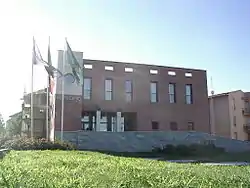 Town hall. | |
Location of Dresano 
| |
 Dresano Location of Dresano in Italy 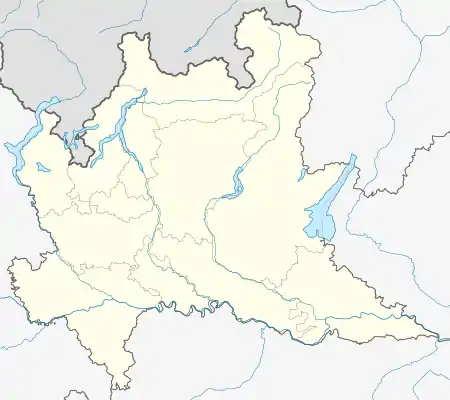 Dresano Dresano (Lombardy) | |
| Coordinates: 45°22′N 9°22′E | |
| Country | Italy |
| Region | Lombardy |
| Metropolitan city | Milan (MI) |
| Government | |
| • Mayor | Vito Penta |
| Area | |
| • Total | 3.48 km2 (1.34 sq mi) |
| Elevation | 91 m (299 ft) |
| Population (30 November 2017)[2] | |
| • Total | 3,041 |
| • Density | 870/km2 (2,300/sq mi) |
| Demonym(s) | Dresanesi |
| Time zone | UTC+1 (CET) |
| • Summer (DST) | UTC+2 (CEST) |
| Postal code | 20077 |
| Dialing code | 02 |
| Website | Official website |
Dresano borders the following municipalities: Mediglia, Tribiano, Mulazzano, Colturano, Vizzolo Predabissi, Casalmaiocco.
Etymology
The name Dresano is due to the presence, in these swampy areas, of three inlets, three "sinuses", from which the name evolved over the centuries: Tresseno, then Tressano and Tresano, and finally Dresano. The three inlets appear in the coat of arms too, surmounted by three poplar trees, the poplar being one of the most typical local trees.
History
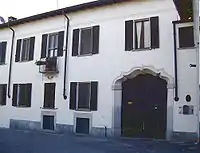
.
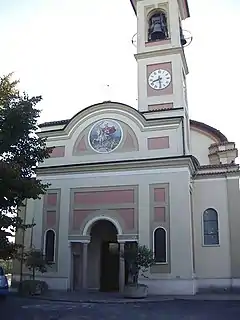
The old village hosts the remains of one of its most ancient buildings: on the East side of Piazza Manzoni the wall of an establishment with a massive wooden double door is found, which was part of the convent of the benedictines, who performed the hard task of draining and cultivating the swampy territories around. In this area malaria (swamp fever) took its toll.
Climate
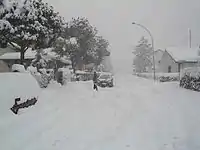
The climate in Dresano is characterised by sultry summers, and rainy, cold winters. Occasionally, heavy snowfall occurs; in 1995 a particularly heavy snowfall blocked the roads, paralysing traffic and forcing schools to close for several days.
The end of August-early September is characterised by violent thunderstorms and heavy sleet which signal the end of summer.
Topography
The village is divided into four smaller areas: the old village (Dresano vecchio), Madonnina (built in the 1960s), Villaggio ambrosiano (erected in the 1970s) and Villaggio Helios (begun in the 1990s).
The old village shows one of the oldest farms in the area, Cascina Belpensiero, which displays a secular tree in the middle of the farmyard. This dairy farm is already mentioned in written historical sources dating back to 1500, and it is still surrounded by fields, 1 kilometre (0.62 mi) from the village.
Every year, in May, the dairy farm holds the traditional "Quater Pass per un Vitel", an amatorial footrace, organised by the local sports group Gruppo Sportivo Marciatori San Giorgio (San Giorgio being the local patron saint). The prize for such race is a live calf. There are three different options for the race: 6 kilometres (3.7 mi), 12 kilometres (7.5 mi), and 21 kilometres (13 mi).
Sport
Sport associations in Dresano include:
- Gruppo sportivo marciatori San Giorgio (walkers' group)
- Auser (providing assistance to the elderly and the disabled)
- Dresano Calcio (soccer team)
- Dresano Basket (basketball team)
Events
- Carnevale dresanese (carnival): February
- Dresano fiorita (flower show): 2nd Sunday of April
- "Quater pass per un vitel": 1st Sunday of June (footrace)
- Marcia Serale del Belpensiero (footrace): June (non-competitive footrace by night)
- Festa dell'uva (grapevine fair): 2nd Sunday of September
The gym and the municipal library, managed by volunteers, are located in the school complex of the Villaggio ambrosiano.
Ecology
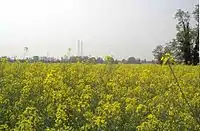
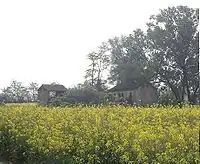
Dresano owns a water purification plant. The water purifier can be found along the Addetta floodway, close to Balbiano.
Fields in Dresano territory are intensely farmed. The most popular cultivations are:
- wheat
- barley
- fodder maize
- oilseed rape
Biodiversity
Dresano, a farmland tradition town, has shown in the last few years an increased level of biodiversity, thanks to various animal and plant species, that live mainly along waterways.
Wildlife
Local noticeable wild animal species, especially on the Addetta floodway banks, include:
- Grey heron (Ardea cinerea)
- Pheasant
- Common chaffinch (Fringilla coelebs)
- Moorhen
- Little egret (Egretta garzetta)
- Mallard (Anas platyrhynchos)
- Kingfisher
- Common blackbird (Turdus merula)
- Green woodpecker (Picus viridis)
- Song thrush (Turdus philomelos)
- Common nightingale (Luscinia megarhynchos)
- European rabbit
- European hare
- Coypu (nutria)
- Bat
- European hedgehog
- Fox
- Bumble bee
- Dragonfly
- Glow-worm
- Mediterranean barbel
- Crucian carp
- European chub
- Pumpkinseed (common sunfish)
- Walking catfish
- European perch
- Common rudd
- Tench
- Western green lizard
- Frog
- Toad
- Swollen river mussel
- a black and red huge crayfish, not yet identified
Flora
- Humulus lupulus, also called wild asparagus, but it is actually a species of the hop plant. It can be added to soups, omelettes, salads, rice, or boiled and dressed with olive oil and lemon.
- Evergreen hawthorn
- Roman chamomile
- Horsetail
- Fig (Ficus)
- Black mulberry
- Scarlet rose mallow
- White horse-chestnut tree
- Peppermint (brandy mint)
- Walnut
- Hazel
- Onice, women's clogs were once made with this wood, since it doesn't warm the feet too much.
- Plane tree
- White poplar
- Black poplar
- Aspen
- Wild plum tree
- Black locust (false acacia)
- Blackberry bush (blackberry bramble)
- elder
- Grapevine
References
- "Superficie di Comuni Province e Regioni italiane al 9 ottobre 2011". Istat. Retrieved 16 March 2019.
- All demographics and other statistics: Italian statistical institute Istat.